- Kettle corn is a kind of popcorn that’s sweet and salty in taste.
- The name comes from the traditional way of cooking it in a cast-iron kettle.
- Kettle corn is typically made from naturally gluten free ingredients.
- Kettle corn is gluten free unless it has gluten-rich ingredients additives, or there’s cross-contamination.
Is kettle corn gluten free? YES, natural kettle corn is GF and most brands are GF as well.
I simply love pop corn, or kettle corn, I can’t eat enough of it, and when I found out I had Celiac, this was a major issue for me. In this post we want to give you all the info needed on kettle corn and if it’s safe for people who don’t eat gluten.
Is it sweet? Is it salty? Kettle corn is a kind of popcorn that has a unique taste. It is made of sugar and salt, and that gives it a caramel coating.
What sets it apart from other types of popcorn is not just the sweet-and-salty taste but the traditional method of preparing it using a cast-iron kettle.
Confidence score of Kettle Corn
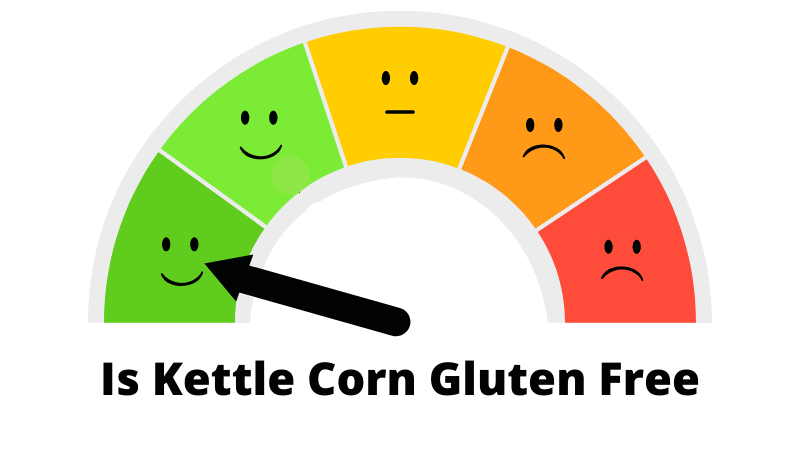
We score this a 9/10 as most brands sell GF and also naturally this snack is GF as well.
It’s a sweet snack that everyone loves. It is a simple popcorn recipe with just a few ingredients. But does it contain gluten?
For anyone with an allergy to gluten or celiac disease, every food item needs to be scanned for gluten content, including kettle corn.
The ingredients used for making kettle corn do not contain gluten. So, we can conclude that it is gluten free.
But there are many flavors of kettle corn with additives that might contain traces of gluten. Of course, there’s always the possibility of cross-contamination, too.
Is Kettle Corn Gluten Free?
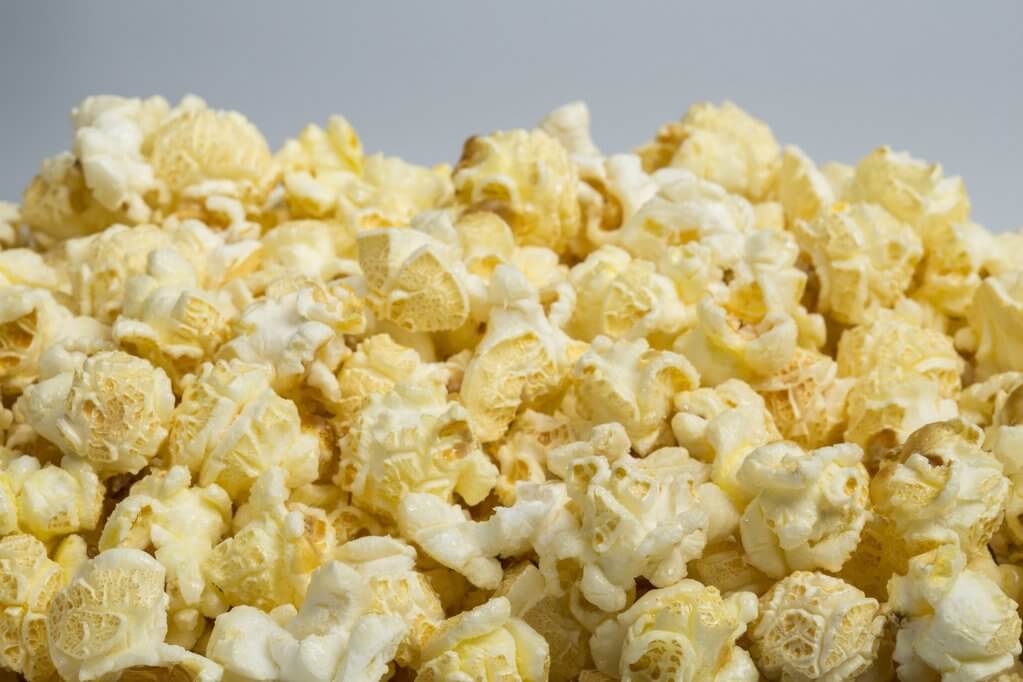
Your life can never be the same once you taste kettle corn. You will get addicted to the beautiful sweet and crunchy snack with a hint of saltiness.
It’s an addictive snack that you just can’t stop stuffing into your mouth. But, like all edible items, we’re here to find out one thing – is kettle corn gluten free?
If you’ve tasted kettle corn, you already know that kettle corn is a form of popcorn made with corn, oil, sugar, and salt.
Traditionally, this kind of popcorn is popped in a cast-iron kettle. But people also use regular pots and pans in the kitchen.
You either add all the ingredients at the time of popping or season the popped kernels with salt and sugar. Sometimes, other additives are also used to make it more fun.
The good old kettle of corn is made using ingredients that are naturally gluten free. Let’s look at them one by one, shall we?
Let’s start with corn, the main ingredient of popcorn. Corn is free from gluten.
In fact, if you have gone gluten free, you’ve probably replaced gluten grains with corn and wheat flour with cornflour.
But in some rare cases, people with celiac disease or gluten intolerance may face inflammatory reactions to maize prolamins in corn. But this is extremely rare, and for most people, corn is safe.
The other ingredients in kettle corn are the seasonings, i.e., salt, sugar, and oil.
Both salt and sugar are free from gluten. The types of edible oil that we usually use, like olive oil, vegetable oil, canola oil, and more, are free from gluten.
So there is no opportunity for these ingredients to add gluten to the snack. Clearly, kettle corn is made from naturally gluten free ingredients. Therefore, it contains no gluten.
Possibility of Gluten Ingredients in Flavored Kettle Corn
Do you know that besides the regular old kettle corn, there are many different kinds of flavored kettle corn available? These are the fruits of the imagination of people who love to experiment in the kitchen.
That’s where the problem starts! It’s possible for the additives in flavored kettle corn to have gluten.
For instance, the flavored kettle corn, or any form of flavored popcorn as such, may contain spice blends or toppings with gluten fillers in them.
It may also have glutenous flavoring agents, such as wheat starch, or malt-containing flavorant. Don’t forget coloring agents that may also have gluten content.
What about Cross-Contamination of Kettle Corn?
As you can understand, kettle corn has no reason to contain gluten unless gluten-containing additives are used to make flavored kettle corn.
But that’s not all. Another way it can end up with gluten content is through cross-contamination of the kettle corn or any of the ingredients added to it.
What is cross-contamination? The kettle corn you’re buying may have been prepared in facilities that also work with gluten foods.
Thus, it may come into direct contact with traces of gluten in the manufacturing, packaging, or storage units and end up with small amounts of gluten itself.
The same may happen to individual ingredients or additives, i.e., each of them runs the chances of cross-contamination at different stages.
Can you guess what happens when such additives are used in making kettle corn? Your favorite sweet snack also ends up with trace gluten.
It sounds like cross-contamination can only contribute to small traces of gluten, right? Be warned, because this small amount may be enough to trigger allergic reactions if you are severely sensitive.
Cross-contamination is a possibility even at home if you’re not careful about the utensils you use.
How to Check the Gluten Free Status of Kettle Corn
So how will you know if you’re safe? As we always say, the answer is written on the label of the product.
If any flavored kettle corn contains a gluten-containing additive, the list of ingredients on the label of the product should mention it.
Reliable food brands that care for customers always reveal gluten content. You can also reach out to the company directly to verify if the kettle corn is safe for your consumption.
Of course, you can always look for a kettle corn brand that’s certified as gluten free.
Do you know how to look for the certification? Simply look at the package to see if there is a “gluten free” seal or if the words “gluten free” are on the box of your kettle corn – or of the ingredients if you will make it at home.
Why is the label important? The certification clearly indicates that the end product has been tested to reveal that it contains less than the permissible limit of gluten, i.e., 20 ppm.
It also means that the facilities where the product is made or packaged do not handle gluten products, thus eliminating all chances of cross-contamination. So, a certification is a sure-shot proof that the item is gluten free.
If you want to make kettle corn at home and wish to experiment with flavors, make sure to pick up additives or ingredients that are certified as gluten free.
Also, prepare and store the kettle corn and its ingredients in utensils and containers that have not been in contact with glute products.
You will also find kettle corn at movie theatres or carnivals, where the snack is freshly made and served.
There is no way to have these tested or certified, of course. So, it’s a good idea to avoid flavored kettle corn in this case. Your best option is to pick the good old kettle corn that has no possibly-glutenous additives.
Ideally, it shouldn’t cause allergic reactions, unless you’re particularly sensitive to trace gluten.
What is Kettle Corn anyway?
So you love kettle corn as your favorite sweet snack. But have you ever wondered how this beauty came into being?
It might surprise you to know that even though it has been popular recently, it was first introduced to the United States back in the early 18th century – and the credit goes to the Dutch!
The earliest mention of kettle corn was in Dutch diaries found in Pennsylvania, back in 1776. Later on, in the 1970s, kettle corn suddenly became popular again in America.
It became a common sight at farmers’ markets, carnivals, festivals, and other live events. You’ll also find them at movies or in supermarkets.
Somewhere in the 20th century, the popularity of kettle corn began to wane, only to return in the 21st century. The traditional recipe for kettle corn calls for the popping of corn in the cast-iron kettle.
In this process, the kettle is seasoned with oil. The salt and sugar are added to it with the corn.
As the sugar starts to melt and mixes with salt, a delicious syrup is formed. The oil helps a thin layer of this liquid stick to the corn kernels while they pop in the kettle.
This method needs a little babysitting: you have to move the kettle constantly to stir its content, or the sugar might burn.
To avoid this constant monitoring of the corn kernels while they are cooked, another method is used. In this method, freshly popped, hot popcorn is first coated with sugar or honey, and then salt is added.
The interesting thing about kettle corn is that the same ingredients can lead to different textures and flavors.
Does that mean you can’t make kettle corn if you don’t have a heavy iron kettle or Dutch oven? That’s not it at all! You can easily make kettle corn using any deep-bottom pan in your kitchen.
That way, if you put the sugar in the pan at the time of popping the kernels, stirring the lightweight pan will be much easier. You will also find microwavable versions of kettle corn that are much easier to cook.
Here’s a trick to understanding the flavor profile of the uncooked kettle corn sold in packages.
These contain salt, oil, sugar, and salt – you have to put them in the microwave like regular popcorn, and the kettle corn will be ready. But how will this taste? Is there a chance for it to be too salty, sweet, or oily?
To find out, look at the label. If the fat content is high, it means that the final kettle corn will be a little oily and heavy.
So the lower the oil content in the package, the lighter your popcorn will turn out to be. As for the taste, there is a whole other story, as you have to analyze the package size and the content.
Most of the kettle corn packages contain just about 7 ounces of corn. However, the total weight of the box is much more than that.
It can be almost double this weight, which means that this excess weight is that of sugar, salt, and oil.
The higher this total weight, the more sugar, and salt it contains, leading to an excess of sweetness and saltiness in the kettle corn. It can also give you heavy popcorn.
Many people think that kettle corn is the same as caramel popcorn. In caramel popcorn, molasses are usually used for caramel.
Related: Are lady fingers gluten free | Is risotto gluten free
The corn kernels are air-popped first and then coated with the syrup to give a crunchy coating. Thus, the difference between kettle corn and caramel popcorn is in ingredients and the making process.
As for the texture, the entire caramel popcorn will be covered in sticky caramel.
Best Gluten Free Kettle Corn Brands
| Orville Redenbacher’s | Act II |
| Angie’s BOOMCHICKAPOP | Jolly Time |
| Black Jewell |
Are you looking for store-bought packages of kettle corn that you can enjoy eating at home? Thankfully, there are a couple of reliable brands out there for you. Here are a few gluten free kettle corn brands that you can check out:
a) Orville Redenbacher’s
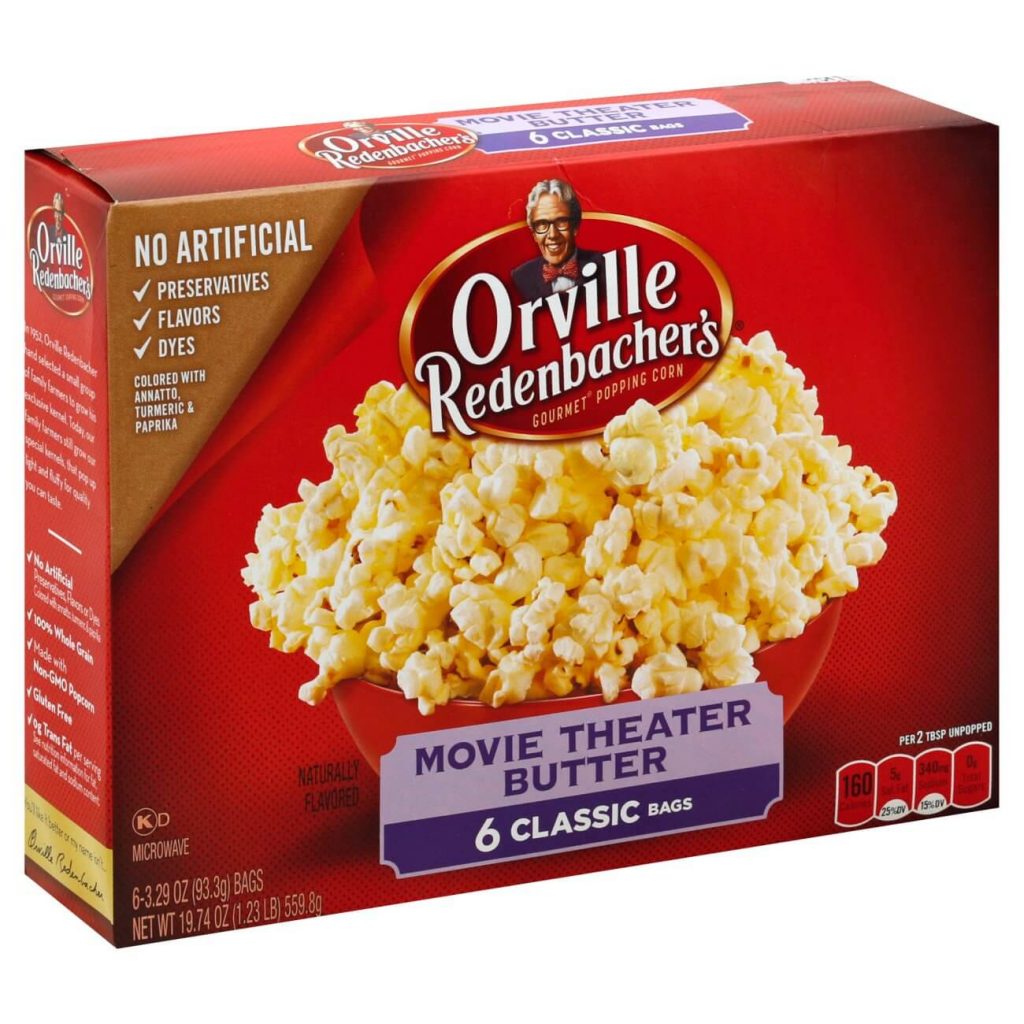
Orville Redenbacher’s range of popcorn has seven delicious flavors, including the Kettle Corn. The package of this microwavable kettle corn proudly flaunts the “gluten free” tag to ensure that it’s safe.
b) Act II
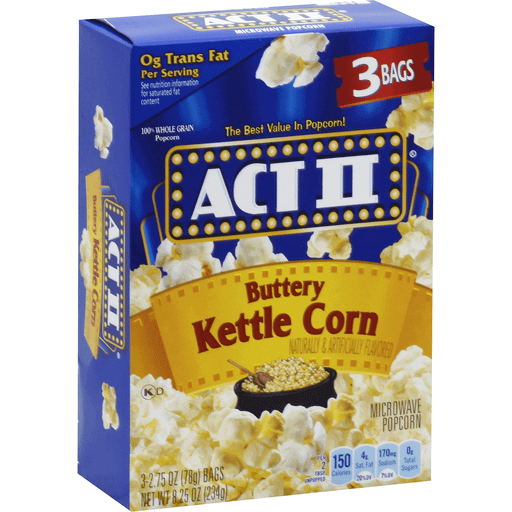
One of the most popular popcorn brands in the world, Act II, offers eight popcorn flavors, and the Kettle Corn is one of them. Like other flavors, Act II kettle corn is also certified as gluten free.
c) Angie’s BOOMCHICKAPOP

Among a host of other popcorn, the brand brings you two variants of ready-to-eat kettle corn: the Sweet ‘n Salty Kettle Corn and the Light Kettle Corn. These are all gluten free, with less than 10 ppm.
d) Jolly Time
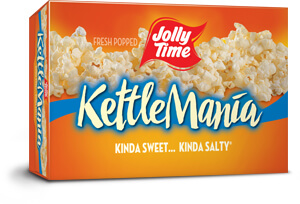
Jolly Time has been around since 1914, giving Americans “outrageously fun” to devour. One of its popular flavors is the Kettle Mania, which, like its other flavors, is certified as a gluten free product.
e) Black Jewell

Yet another popcorn brand to show off the “gluten free” certification on the package, Black Jewell has a number of flavors on offer, including the Sweet and Salty Kettle. It’s pure popcorn – and pure happiness!
Thanks to these brands, you won’t have to go on a hunt for gluten free kettle corn or pick package after package, reading through the labels to figure out which one is safe for you.
Home-Made Kettle Corn Recipes
Do you love to flaunt your skills for cooking gluten free food? Here are two super-fun kettle corn recipes! As long as you use ingredients that are free from gluten, you’ll be safe.
a) Gluten Free Kettle Corn Recipe
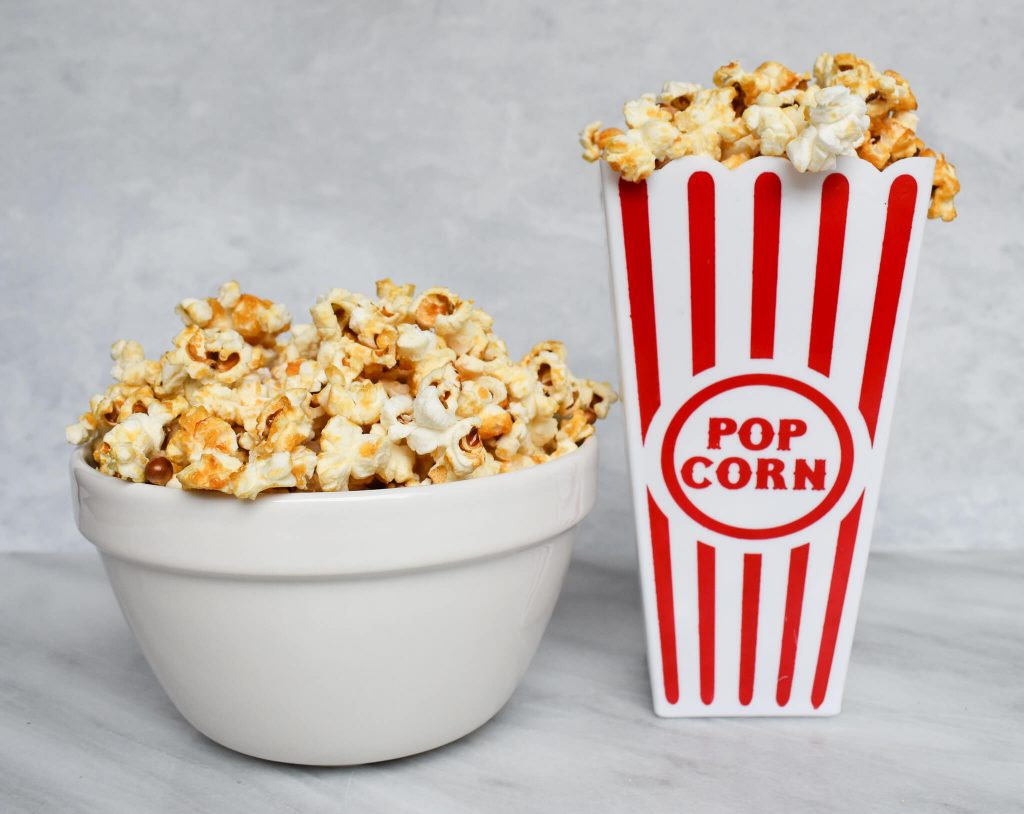
Let’s start with the plain old kettle corn – minus the iron skillet to make the job easy for you.
Ingredients:
- Vegetable oil: ¼ cup
- White sugar: ¼ cup
- Corn kernels (unpopped): ½ cup
- Salt: ⅛ to ¼ tsp
Instructions:
- Take a large pot and heat the oil in it. Add 3-4 unpopped kernels.
- Once the kernels start to pop, the oil is ready. So stir in the corn, along with the sugar and salt.
- Cover the pot. Don’t forget to keep shaping the covered pot to prevent the sugar from burning.
- You will soon start to hear popping sounds. Let that continue till you notice a gap of 2-3 seconds between each pop.
- Remove the pot from the heat at this point. Don’t stop shaking the pot until you stop hearing the popping.
Now transfer the content to a large bowl and let the kettle corn cool down. If you see the popcorn clumping together, stirring the batch occasionally will help to separate them.
b) Gluten Free Rainbow Kettle Corn Recipe
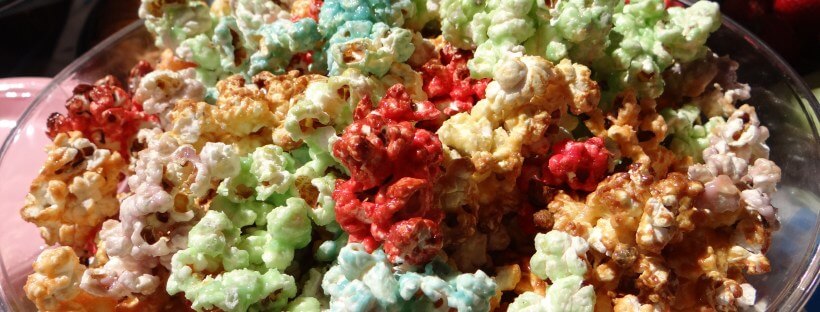
A delightful addition to any party, be it Halloween night or your kid’s birthday, the blast of color in a bowl of rainbow kettle corn will be an instant hit!
Ingredients:
- Sugar: 12 tbsp (divided into 6 equal parts)
- Food coloring: 6 colors (2 drops of each)
- Coconut oil: 6 tsp (divided)
- Popcorn kernels: 12 tbsp (divided into 6 equal parts)
- Kosher salt: To taste
Instructions:
- Take all the sugar and divide it into 6 small bowls. Each bowl will have 2 tbsp of sugar.
- Now, add two drops of food coloring in each bowl. Dye each bowl of sugar in a different color. Stir the drops in the sugar with a fork till you get a sandy mix in each bowl.
- Set a pan on medium-high heat and add 1 tsp of oil in it, along with 2 kernels of corn. Cover the pan and wait until the kernels pop.
- Bring the heat down to medium and add 2 tbsp of corn and the content of any of the bowls containing dyed sugar.
- Cover the pan immediately and start shaking it. Let the corn kernels pop, till you hear them popping at a gap of 3 seconds or more.
- Remove the pan from the heat and keep shaking before the popping stops. Then transfer the colored kettle corn to a bowl. Sprinkle a pinch of salt and stir it.
- Repeat the same process five more times for every other color. You will end up with six bowls of kettle corn in six delightful colors.
- Take a large bowl and transfer the content of all the bowls into it. Now, stir them properly so that the colors are evenly distributed in the bowl.
Your stunning bowl of rainbow popcorn is ready. Look for gluten free gel coloring for this recipe as they are easier to cook with, and healthy, too.
Conclusion:
If you have celiac disease or gluten allergy, kettle corn is usually a safe snack option for you. It is made by seasoning corn in oil, sugar, salt – and all of these are naturally gluten free.
So, kettle corn is safe for you to consume unless cross-contamination adds gluten to it, or you’re severely sensitive to trace gluten.
But you need to be careful about flavored kettle corn, as these variants may contain gluten-rich additives.
So, if you avoid flavored kettle corn, you’ll likely never face any problem, even if you buy the ones that are popped in front of you and sold in open tubs or boxes at movies, carnivals, or festivals.